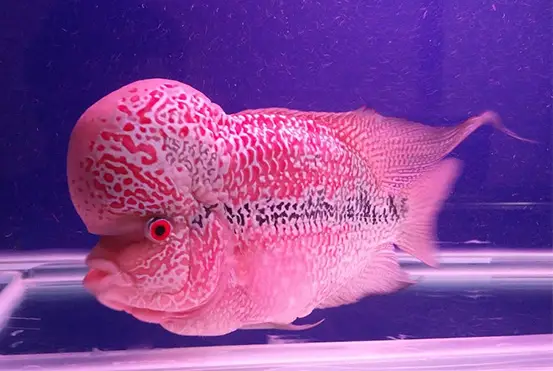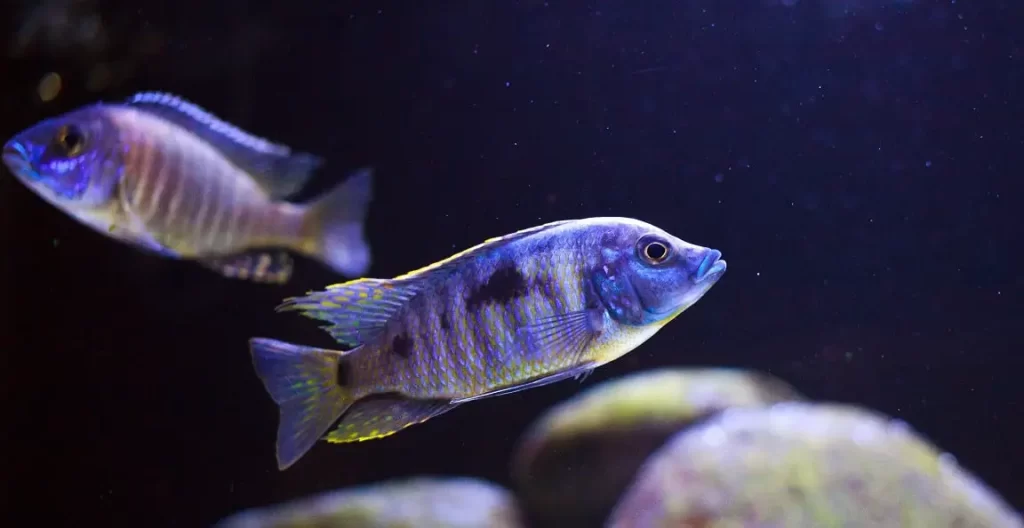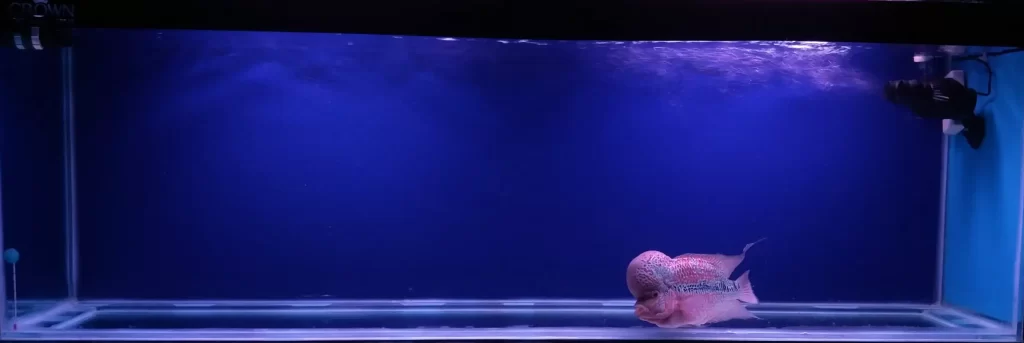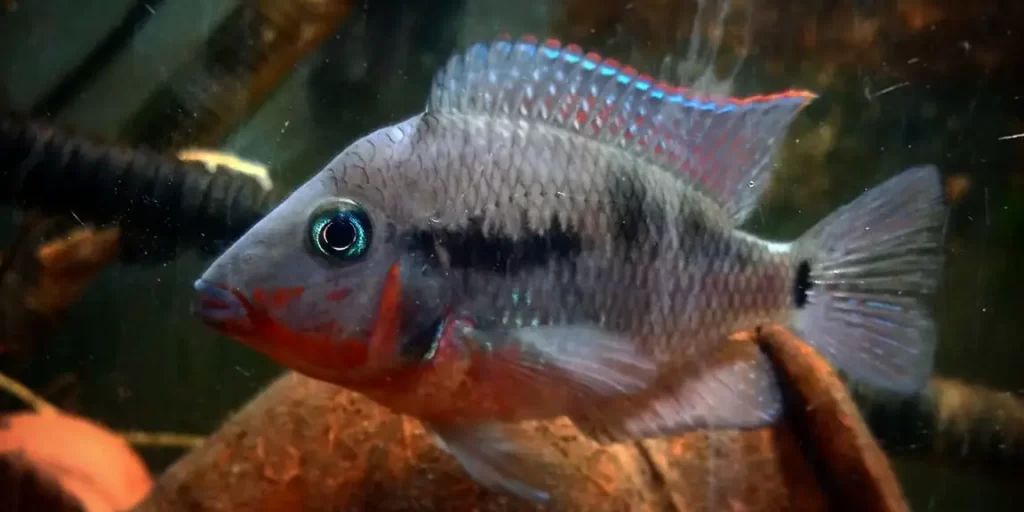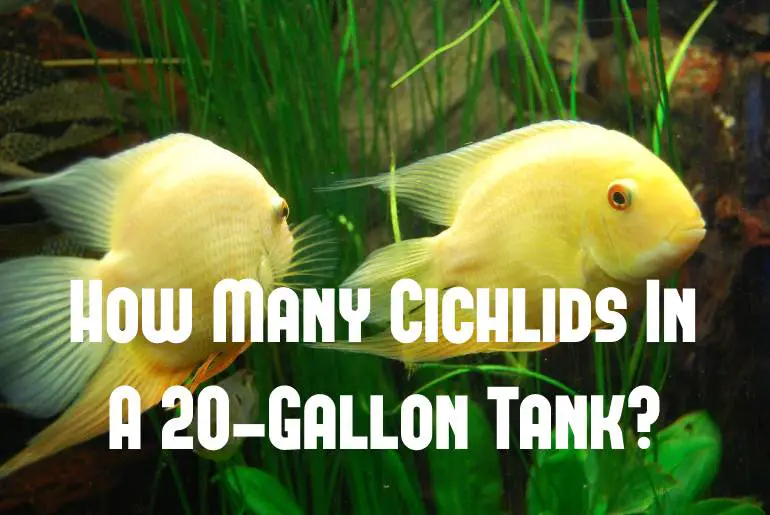The Flowerhorn Cichlid Fish is one of the most popular aquarium fish with a very interesting behavior, temper, and completely unique appearance. Flowerhorn cichlids have a great personality and you will not regret keeping Flowerhorn cichlid as a pet. The Flowerhorn is Manmade Hybrid Fish that means, they are not found in the wild. The unique eye-catching appearance is a result of the interbreeding of different cichlids. And also Flowerhorn care is very easy since the fish can adopt a wide range of water perimeter. However, you should set up a tank for flowerhorn fish the right way.
Cichlids, as a rule, aren’t very critical while choosing their pair. Therefore, they can make a pair not only with their kind but also with other cichlid types. This peculiarity gave Flowerhorn breeders a possibility to obtain an amazing wide type of hybrid fish. Not all the hybrids are successful though they can be paired with any cichlids. Some of them have good body structure, coloration, or becomes sterile (not able to produce children) like the parrot fish. Parrotfish, one of the most popular cichlid, is exactly the best result of artificial cross-breeding that is sterile. The evolution of Flowerhorn Cichlids came from careful and continuous cross-breeding of various types of cichlids by Malaysian breeders.
Prevention Is Better Than Cure:
Always Wear a Protective Mask when you go out. Its better to use a N95 Mask.
Always Wear a safety Goggles.
Make Sure you Wash your hand with a soap for at least 20 Seconds.
Carry A sanitizer when you go out.
One of the interesting features of the Flowerhorn Fish is that it changes its coloring patterns during its life, evolves until it becomes a fully mature adult fish. So, if you are interested in keeping Flowerhorn Cichlid with a particular color pattern, you will have to choose the fish from mature fish. Else, if you choose to purchase a young fish, you can look forward to watching its color and patterns develop. Either way, Flowerhorn fish is always a great pet to own.
VIPARSPECTRA Timer Control Dimmable 165W LED Aquarium Light
Hygger Saltwater Tank Titanium Tube Submersible Pinpoint Aquarium Heater with Digital Thermostat
Flowerhorn Cichlid is easy to care for and are hardy fish. They can adopt a wide range of temperatures and water perimeters. They are massive fish, they can typically grow between 12 – 16 inches or 31 – 41 centimeter in size, thus, requires a large tank of at least 75-Gallons in volume for themselves. Flowerhorn fish are territorial and aggressive fish and are best kept singly as a show fish.
Get Yourself a tank first: R&J Enterprises R&J 50 Gallon White Grain Fusion X Fish Tank Stand with Rimless Glass Tank Combo, Dual Pumps with Built-in Filtration
If you want to keep them with other tank mates then they should be kept in a tank larger than 175-gallons. And also, they love to dig into the substrate and eat any plant matter in the aquarium. Because they have an affinity for digging they are able to move a significant amount of substrate and other hardscape materials like rock decorations due to its size. So, rather than placing decorations and rocks on the substrate, I recommend you to put rocks, and other decorations directly on the tank bottom.
Best Filter for Filwerhorn tank:
Fluval Carbon Filter Media for Aquariums
Hydor Professional External Canister Filter – Aquarium External Filter
Marineland Magniflow Canister Filter for Aquariums, Fast Maintenance
Origin of Flowerhorn
Flowerhorn fish is a hybrid fish, artificially bred in captivity, which means the fish does not exist in the wild. The first hybrid was created in Malaysia in the mid-1900’s by Malaysian breeders cross-breeding various species of cichlids, primarily South American Cichlids. Breeders were amazed by its “Kok” i.e. the hump on the head so, started calling them “Karoli” i.e. Fighting Ship.
The question of what kind of South American cichlids were bred to create Flowerhorn is a well-kept secret only known by the breeders who worked to develop these fish. Aquarists agree that the Flowerhorn fish is the outcome of successful breeding of these different kinds of cichlids: Cichlasoma Citrinellum, Cichlasoma Trimaculatum, Cichlasoma Labiatum, Vieja Synspila and Cichlasoma Festae.
The First generation Flowerhorn Cichlids are still known as the Hua Luo Han Cichlids. The hybrid was developed in 1998 by cross-breeding the hybrid Jingang Parrot with the Original Blood Parrot. Today the most popular Flowerhorn Types are KanFa, Thai Silk, Zhen Zhu (ZZ), Super Red Dragon, Kamaula (Golden Monkey), Golden Base Flowerhorn, Pearl Scale Flowerhorn etc.
Best Filter for Flowerhorn Tank:
Fluval Carbon Filter Media for Aquariums
Hydor Professional External Canister Filter – Aquarium External Filter
Marineland Magniflow Canister Filter for Aquariums, Fast Maintenance
Flowerhorn Types
When talking about Flowerhorn Cichlids keep in mind that, these fish are created cross-breeding different types of cichlids. There are more than 1000 varieties of cichlids in existence. And it’s impossible to know how many different types of Flowerhorn are in existence.
Flowerhorn fish are prized for their Kok or hump on their head, their colors and Flowerhorn line.
Some of the most popular types of Flowerhorn Fish are :
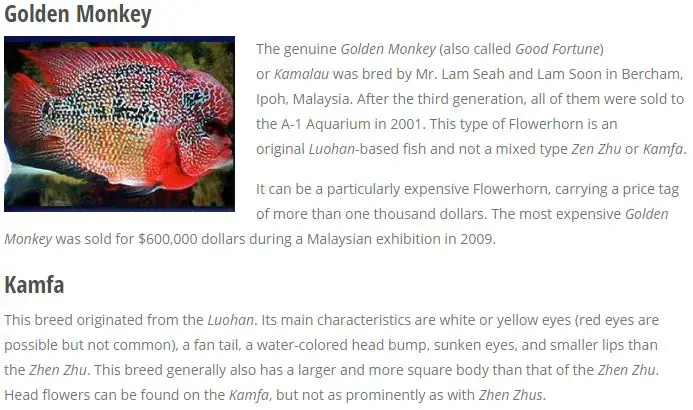
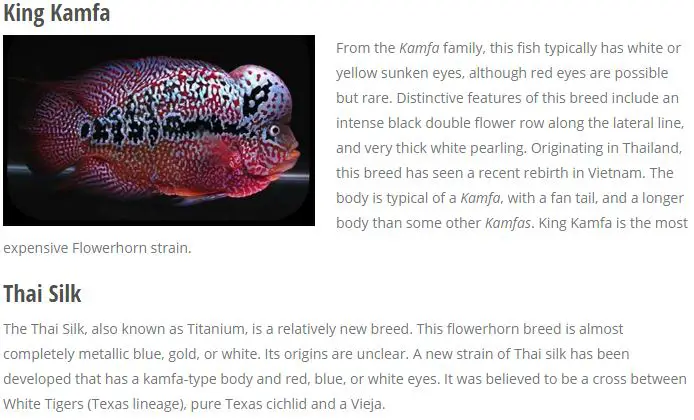
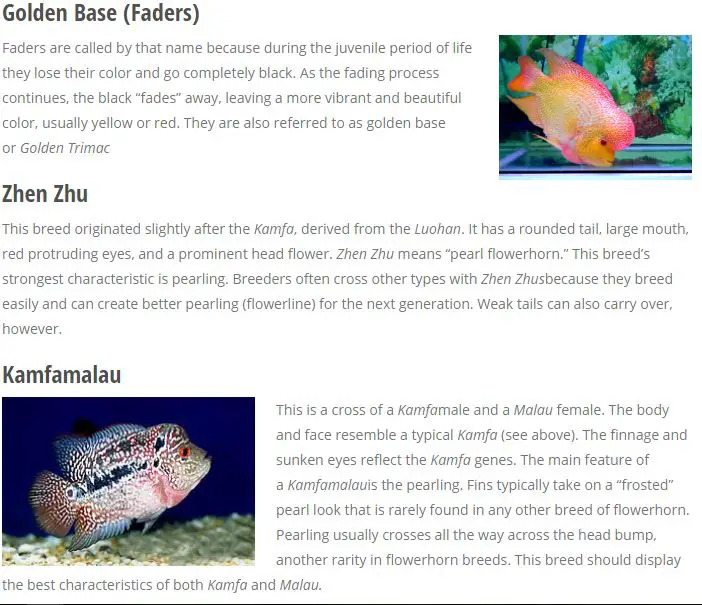
Flowerhorn Description
Flowerhorn Fish is an American Cichlid with a large, bulky and oval body with fan-shaped fins and bright colored Kok in its head. They are large fish reaching between 12 – 16 inches in length. In most of the strains, the fish has a black horizontal marking in its body. The fish has long and pointed dorsal and anal fins while their caudal fin is rounded, spade-like appearance. Flowerhorn cichlid lifespan is about 8 – 10 years.
I often hear people asking about how to choose a Flowerhorn cichlid. When choosing an adult there are 7 characteristics you need to look for. These are called as “The Flowerhorn Fish Standards”. These includes:
The fish body: The fish body has to be oval-shaped with the big and bulky rounded abdomen,
Occipital hump: The Kok should be big and symmetrical to the body size,
Black horizontal lining: It is important for them to be thick since this is the main Flowerhorn feature,
Coloring: Most of the common Flowerhorn fish are red. Any color that is bright and well defined is acceptable,
Fins: Fluke, erect and has to be as large as possible,
Eyes: the fish should have alert distinct eyes,
Fish scales: pearl scales and shiny.
Flowerhorn Care Difficulties
Flowerhorn care is rather easy, the fish is recommended for those beginners who are familiar with their behaviors, aquarium setup requirements and probable expenses. They are hardy fish, they can adopt a wide range of water parameters and accepts any food you provide them. Though, they should be fed a high protein diet. Flowerhorn fish food includes protein-based foods, including pellets, live foods, frozen foods, flake foods, etc.
Always Use: API Freshwater Master Test Kit
Best Food For Your Flowerhorn (For both the color and head size):
Freeze Dried Brine Shrimp Cubes
Omega One Super Color Cichlid Pellets Small Sinking
Ocean Free Set 120 g Humpy Head Ever Red Size M Pellets Xo Flowerhorn Fish Food
Automatic Feeder: Eheim Automatic Feeding Unit
Being said that, although they seem to be a perfect beginner’s fish, it is not recommended for beginners to keep the fish for a few reasons.
Firstly, Flowerhorn Cichlid is a very large fish reaching up to 12- 16 inches. The fish requires a large and expensive tank with a good filtration system.
Secondly, Flowerhorn Cichlids are very aggressive and are territorial. So, they are kept singly in a tank without tank mates, substrates, decorations, and even live plants.
Finally, Flowerhorn Cichlids are difficult to maintain due to their aggressive nature. They often bite their owner’s hand while feeding or maintaining the tank. And believe me, these bites are very painful ones.
However, if you feel that this is the fish you want and you can give all the care to the Flowerhorn this is absolutely the fish for you.
Learn more about flowerhorn diseases and treatments.
Flowerhorn Fish Food
Flowerhorn Cichlids is a carnivore, they have a large appetite eats both live and dry foods. Their diet includes high-quality cichlid pellets, krill, earthworms, crickets, frozen bloodworms, nightcrawlers, and carotene enhanced supplements. This fish is easy to underfeed, so you need to make sure that you feed the fish enough food. The coloring of the fish can affect the food you feed them, so always feed them high-quality foods.
Flowerhorn Aquarium Setup and Flowerhorn Care Tips
Flowerhorn is a big fish, creates a lot of waste and are territorial, so they need a tank that best suits them. Here is an article that will help you to set up an aquarium for your flowerhorn fish. A tank with the volume of 70-gallons is ideal for a single Flowerhorn Fish, but the larger the better. If you want to keep a breeding pair in a tank then you will need at least of 120-Gallons tank. If you are planning to keep other compatible fish with the Flowerhorn then you will need at least of 200-Gallons tank.
As for the decoration, it’s difficult to create an aqua-scape or hardscape in the Flowerhorn tank. Because they like digging into the substrate and move decorations around the tank. And they don’t like plants in their tank too. I mostly recommend people to keep the Flowerhorn Cichlid in a bare bottom tank. Because it will get easier to siphon the fish waste and the tank looks good as well. Else, if you want to keep some kind of substrate in the bottom of your tank, you can go for gravels and aquarium sand. Make sure that you place your rock and decorations are well bedded on the glass bottom of the tank.
Flowerhorn is hardy fish and is not as sensitive to water conditions, but this does not mean that you should not have a strict maintenance schedule. Because they are large fish with big apatite and are messy eaters, so it’s recommended to have very strong filtration like the Sump System. The tank should be cleaned weekly and you must do 10% water change every week to keep your water healthy for your fish. But do it carefully since they can give you a pretty nasty bite.
Sex Differences
The reliable way to distinguish a male Flowerhorn and a female Flowerhorn is not yet been confirmed. A technique is often used by many breeders to differentiate male and female Flowerhorn Cichlids that is, taking the fish and laying them on their back in your hand out of the water. Gently pressing the belly from below rib cage towards the vent. If it squirts out clear liquid then it’s a male, else it’s a female. The other method of differentiating the fish is that the grown female Flowerhorn Cichlid lays the egg every month even without the male Flowerhorn.
Flowerhorn Breeding
Very ofter mane made fish “hybrids” are not fertile, where Flowerhorn Fish is fertile. It is difficult to breed Flowerhorn fish due to their aggressive behavior towards its tankmates. So, the question arises: “How to breed or reproduce Flowerhorn Cichlids”
The first step in breeding the fish is to understand how to produce juveniles of the same color and Flowerhorn line pattern as their parents. For this breeders must understand well about their breeding line. Else the juveniles will have different body structures and color patterns from their parents.
The Flowerhorn Cichlids requires breeding needs similar to South American cichlids. They need plenty of places to hide so that the female can hide from the male. Or else you are going to see a lot of scars and wound marks on the female’s body. Another way is to divide the tank with a divider or using a net, this makes sure that female is safe. You can also keep a big flat rock near the net on the female side where the female can lay the egg. When she lays the egg on the rock male can fertilize them directing the flow of the water towards the female.
The breeding tanks water temperature should be around 28 Degree Celsius / 82 Degree Fahrenheit. The water pH should be at neutral i.e. pH rating of 7.0. You need to make sure that you feed the parents several times a day. And perform a more frequent water change to prevent the increase in bioload in the tank.
Once the egg is laid and fertilized, both the parents will guard their eggs eagerly. This is the time you let one of the parents to guard the egg. Because, even if the parents get along, the male may attack females thinking it is protecting its fries/eggs from the female. Once the eggs hatch and fry and juveniles are large you can feed them with brine shrimps and crushed high-quality pallets or food flakes.

